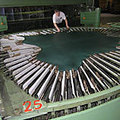More Companies Finding Cost and Carbon Savings in Supply Chains
by: Greener Design, 2011-01-28 22:46:38 UTC
More major companies are tracking their supply chain emissions, and many, along with their suppliers, are also saving money from reducing emissions.

 Congrats to One Size Fits All...LifeEdited Jury Winner!
Congrats to One Size Fits All...LifeEdited Jury Winner!
by: Core77, 2011-01-27 17:30:53 UTC

The results are in! And the Winner of the LifeEdited Small Apartment Design Contest is...One Size Fits All. The announcement was livestreamed today with Graham Hill, founder of TreeHugger, hosting the "awards show." The challenge to redesign Graham Hill's 420sf apartment in New York City aligned with the founder of TreeHugger's mantra to do more with less. Besides a trip to New York City, a $10K consultation contract for the build and a $10K cash prize, the Jury Winner will also receive a prize pack from Cisco and a Strida bike.

(more...)


Tools for Assessing Lifecycle Impact
by: Environmental Leader, 2011-01-25 17:09:26 UTC

 Or, are we “doing the right thing?”
Or, are we “doing the right thing?”
The last couple of postings have focused on how to insure we can measure, and then take credit for (or get some credit for) changes made in a process that creates a positive impact in terms of lifecycle impact or consumption.
This came up with reference to a discussion on net present value (or NPV) which is a way to estimate the degree to which an improvement today leverages benefits into the future. The goal is to identify investments that can be leveraged in the future for big returns.
This brings up the question: what are some methodologies for making these assessments? In earlier posts (see August, 2009 posting) we discussed rates of return for reductions in green house gas emissions, or water use, or energy use. But, how can we identify where to apply technologies (and, more importantly, what technologies to apply) for driving these reductions?
One neat technique that came to our attention for meeting this challenge is called a “pinch analysis.” (See wikipedia for a good description). This came up in a recent project we were doing for a major European automotive manufacturer and the very energy intensive process they were using to clean precision components (including engine blocks and heads) after production to remove contaminants. These contaminants could lead to assembly problems and performance issues in use.
First let’s look at what pinch analysis is, then the process we applied it to and then the results. (And put your thinking cap on, as this will get technical fast!)
Wikipedia describes a pinch analysis as “a methodology for minimizing energy consumption” that was originally developed for the chemical industry. Wiki includes this nice summary of the technique:
“… process data is represented as a set of energy flows, or streams, as a function of heat load (kW) against temperature (deg C). These data are combined for all the streams in the plant to give composite curves, one for all hot streams (releasing heat) and one for all cold streams (requiring heat). The point of closest approach between the hot and cold composite curves is the pinch temperature (pinch point or just pinch), and is where design is most constrained. Hence, by finding this point and starting design there, the energy targets can be achieved using heat exchangers to recover heat between hot and cold streams. In practice, during the pinch analysis, cross-pinch exchanges of heat are [often] found between a stream with its temperature above the pinch and one below the pinch. Removal of those exchanges by alternative matching makes the process reach its energy target.”
This example comes from the MS Thesis of Mr. Saurabh Garg, titled “Solid Particle Contaminant Cleaning in the Automotive Industry,” and done in my lab at Berkeley in Spring 2010. The motivation for this project was the large amount of energy consumed by the cleaning process that is not only a production cost constraint for the automotive industry in the wake of ever increasing energy prices, but also leads to a significant environmental footprint in terms of indirect greenhouse gas emissions. Garg noted that the severity of this impact depends on the energy mix of the geographical area and the impact created by the sources of energy production.
The objectives of the work that form the basis of applying the pinch analysis were:
–to characterize various fluid flows in the process and in external circuits in terms of important parameters such as steady state flow rates, and temperature
–to optimize the energy flows in the system to ensure maximum process-to-process heat recovery potential
–to propose distribution of the net load on external utilities to minimize the overall heating and cooling costs, and
–to analyze and compare the energy requirements of a standalone system of cleaning machines vs. that of centrally heated and cooled machines in a manufacturing assembly line.
So we are dealing with flows of fluids at different temperatures – a relatively common process characteristic in manufacturing (think painting, heat treating, washing, etc.) Not surprisingly, this will involve some simple thermodynamics.
The basic concept of a pinch analysis (as defined above) is represented by the diagram below, showing the temperature – enthalpy rate for a process stream in manufacturing. If you need some brush up on your thermodynamics, check the wikipedia discussion on enthalpy. Enthalpy is, basically, the measure of the total energy of a thermodynamic system. Wikipedia explains that since “the total enthalpy, H, of a system cannot be measured directly … change in enthalpy, ?H, is a more useful quantity than its absolute value. The change ?H is positive in endothermic reactions, and negative in exothermic processes. ?H of a system is equal to the sum of non-mechanical work done on it and the heat supplied to it.” The figure below summarizes the basis of the analysis.

The analysis starts by representing all the process streams in the domain of analysis on a temperature-enthalpy rate (T- ?H) diagram where the vertical (y) axis represents the temperature scale while the horizontal (x) axis represents enthalpy rate. Each process stream is represented by a straight line on this diagram running from the stream inlet temperature (Tin) to the stream target temperature (Tout). For a process with a series of process streams that comprise the whole operation, you make one straight line for each stream in the series. The term ?T stands for the difference between two temperatures.
Since any horizontal distance on the x-axis represents a difference of enthalpies in which we are interested, the absolute values on the x-axis are insignificant. It is precisely for this reason that the composite curves can be translated horizontally on a T-?H diagram, without affecting the process stream. The slope of any line representing a process stream on a T-?H diagram is given by 1/(mass flow rate x Cp). Here Cp is the specific heat of the fluid.
For heat exchange to occur, the hot stream cooling curve (hot composite curve) must lie above the cold stream heating curve. (cold composite curve). Because of the ‘kinked’ nature of the composite curves, they approach each other most closely at one point defined as the minimum approach temperature (?Tmin). The point of minimum temperature difference represents a bottleneck in heat recovery and is commonly referred to as “pinch” as defined earlier by the Wikipedia reference. The area of overlap between the composite curves represents the potential for process-to-process heat recovery. As stated before, horizontal translation of the curves will vary ?Tmin such that at one particular value, the overlap shows the maximum possible scope for heat recovery within the process. At this value the requirement for external hot and cold utilities, as represented by the hot and cold end overshoots of the composite curves, is minimum. However, the maximum process recovery is only a theoretical concept and practical design challenges and cost considerations limit this value as illustrated below.

As seen in the figure, external energy costs increase linearly as the ?Tmin increases. This is because at low temperature difference, the energy transfer process is more efficient and the in-process energy recovery potential is high because the hot and cold composite curves align nicely with each other. In other words, the potential for energy recovery decreases as the composite curves move apart (increasing ?Tmin).
Ok, so how was this used in the automotive cleaning example? The T-?H diagram depicting the hot and cold composite curves for the existing cleaning process (flows of hot and cold fluids at various temperatures) is shown in the figure below. Temperature is along the vertical axis (degrees C) and enthalpy (in kW) is along the horizontal axis. The figure was constructed following the procedure described above (and you may need to ‘click’ on the figure to see all the detail.)
The figure shows that there is a good potential for energy recovery through process-to-process heat exchange, as shown by the green shaded region. The pinch, in this case, is defined by an extended region and not a single position, having a minimum temperature difference of 3 degrees C.
The next step is to propose solutions to “recover” this energy and evaluate whether or not they are feasible economically and, also, what the potential environmental impact will be. A suitable heat exchanger was determined based on the area of heat exchange needed to accomplish the energy recovery. Then, using an economic analysis the potential return of the investment was determined. The figure below compares the total annual energy costs (based on heating and cooling alone) for the proposed retrofit design of the cleaning process based on an improved process-to process
heat exchange optimization vs. the current costs based on the existing design of the process. It can be seen from the figure that beyond the initial 3 years when the capital cost will be completely paid, the net difference between the operational energy costs of pinch-optimized retrofit design and the existing design is worth a savings of 84,500 Euros annually.
Further analysis resulting in considering adding a heat pump to recover some energy due to changes in fluid pressures also. That was good for another 20,000 euro savings annually after the payoff (3 years).
Finally, what about the environmental payback?
Garg includes this analysis as well. The use phase emissions for the existing cleaning process can be attributed directly to the impact created by the consumption of process electricity, and the heating and cooling energy. The total impact for each of these three forms of energy consumption can be calculated by simply multiplying the total energy requirement in each case, with a conversion factor that expresses the impact (kg CO2) per unit kWh based on the source and quality of that energy generation. For example, for a unit (kWh) electricity consumption, the corresponding GWP impact is roughly 0.649 kg CO2 equivalent based on the energy mix of Germany where this facility is located. The same is true for cooling energy, as the cooling is achieved through a refrigeration cycle that involves electricity consumption. For the heating, high temperature steam is used, whose production is linked to an equivalent impact of 0.204 kg CO2 eq./kWh.
Based on the above numbers, the use phase impact generated by the existing cleaning process is found to be 2335 MT CO2 per year. Because of the reduced energy consumption due to pinch optimization, the net impact due to the optimized process is much lower, about 1388 MT CO2 eq. per year – a “savings” of almost 1000 MT CO2 eq. per year!
However, the capital investment in the form of heat exchanger devices will also cause a one-time (fixed) impact, which can be evaluated using, for example, an Economic Input-Output Life Cycle Assessment (EIOLCA) database (e.g. from Carnegie Mellon University). The EIO-LCA analysis for the heat exchanger was used for the given application and predicted an impact of 100 MT CO2 eq. So that is the “embedded” impact of the proposed switch and any improvement needs to be greater than that at the minimum.
Since the reduced impact, almost 1000 MT CO2 eq. per year, is substantially greater than the one time 100 MT CO2 eq. hit due to the production and installation of the heat exchanger we can safely say the GHG return on this investment is pretty good!
There is even better news. This is one cleaning station of dozens in this large automotive facility and, perhaps, hundreds throughout the company. The potential for larger impacts as more are retrofitted, with the same economic and environmental impacts, is tremendous. Talk about a great technology wedge!
And you can use this in your net present value evaluation also.
The point is that there are a lot of existing tools out there that, carefully applied with solid engineering logic, can make a big impact on both bottom lines – cost and environment.
David Dornfeld is the Will C. Hall Family Chair in Engineering in Mechanical Engineering at University of California Berkeley. He leads the Laboratory for Manufacturing and Sustainability (LMAS), and he writes the Green Manufacturing blog.
 Ben & Jerry’s Factory in the Netherlands to be Powered by Ice Cream!
Ben & Jerry’s Factory in the Netherlands to be Powered by Ice Cream!
by: Inhabitat , 2011-01-28 16:10:38 UTC

Ben & Jerry’s, the iconic American ice cream brand, has teamed up with Paques, a biotechnology company, to install a bio-digester in their Hellendoorn ice cream factory in the Netherlands. The new bio-digester will take excess food product that is wasted during the making of ice cream and turn it into power to provide energy for the factory. The bio-digester will cover 40% of the factory’s green energy requirements — will it make the ice cream 40% more delicious too?



Read the rest of Ben & Jerry’s Factory in the Netherlands to be Powered by Ice Cream!http://www.inhabitat.com/wp-admin/ohttp://www.inhabitat.com/wp-admin/options-general.php?page=better_feedptions-general.php?page=better_feed
Permalink |
Add to
del.icio.us |
digg
Post tags: ben and jerry's, biofuel, biofuel electricity, biofuel factory, biofuel from food, biofuel generator, how to make biofuel, innovative energy, innovative fuel, paques
Smart Fortwo Electric Version of the Smart Car Hits the Roads
by: Inhabitat , 2011-01-28 19:08:55 UTC

Following fast on the heels of the release of the Nissan LEAF and Chevrolet Volt, Smart has launched its very own electric car. The first electric Smart car was delivered to Mindy Kimball of Silver Spring, Maryland, a longtime supporter of EVs. It was the first of the 250 Smart ForTwo’s that will be launched in the U.S. this year. The EV will have its official release in 2012.



Read the rest of Smart Fortwo Electric Version of the Smart Car Hits the Roadshttp://www.inhabitat.com/wp-admin/ohttp://www.inhabitat.com/wp-admin/options-general.php?page=better_feedptions-general.php?page=better_feed
Permalink |
Add to
del.icio.us |
digg
Post tags: clean transportation, electric car, electric vehicle, green transportation, green vehicle, plug-in car, smart car, smart electric, smart electric car, smart fortwo electric, smart fortwo electric drive
NYU ITP Students Develop Bioremediating Aquaponics, Hydroponic Furniture and Other Living Systems
by: Inhabitat , 2011-01-28 21:10:38 UTC

This past semester the Interactive Telecommunications Graduate Program at NYU’s Tisch school conducted its first ever course in living systems, which encouraged students to take on projects related to ecology, environmental data management, and, obviously, living systems. After six months of field trips (including a visit to Inhabitat favorite, The Omega Institute), in-depth discussions, and in most cases, very late nights on computers guided by Open Source Cities’ Marc Alt, the results were incredible. From location-based socially networked computer plants, to human breast milk, to moss-shrouded air-quality monitor polygons, the students covered almost every base possible – read on for a look!








Read the rest of NYU ITP Students Develop Bioremediating Aquaponics, Hydroponic Furniture and Other Living Systemshttp://www.inhabitat.com/wp-admin/ohttp://www.inhabitat.com/wp-admin/options-general.php?page=better_feedptions-general.php?page=better_feed
Permalink |
Add to
del.icio.us |
digg
Post tags: green design, Interactive Telecommunications Graduate Program, living systems, NYU ITP, sustainable design, technology in botany, technology in gardening, tisch school, urban food systems
Iffy Table is a Modern Surface Made of Salvaged Urban Wood
by: Inhabitat , 2011-01-28 21:45:26 UTC

The brainchild of head furniture designer Sean Gorham at Urban Tree Salvage, this minimalistic table is made from a reclaimed hardwood live edge slab measuring 48”w x 120”L x 4” thick. Called the Iffy Table, the piece was intended to better allow for proper seating without the invasive knee knocking that happens with some more traditional pedestal bases. The unique spacing of its leg might make it look wobbly, but it’s all an illusion; the table is actually stable enough to stand on.
Permalink |
Add to
del.icio.us |
digg
Post tags: "green furniture", eco design, eco furniture, green design, green products, green table, iffy table, reclaimed wood table, recycled table, sean gorham, urban tree salvage
Cella Energy Announces Emission-Free Gas for $1.50 Per Gallon
by: Inhabitat , 2011-01-27 19:03:22 UTC

This sounds like a dream, but UK-based company Cella Energy claims to have developed a synthetic fuel that has no carbon emissions and would cost only $1.50 per gallon. The hydrogen-based fuel, which is created using a complex hydrides-based technology, has been in the works for over four years at Rutherford Appleton Laboratory near Oxford. The study was led by Professor Stephen Bennington in conjunction with scientists from University College London and Oxford University.


Read the rest of Cella Energy Announces Emission-Free Gas for $1.50 Per Gallonhttp://www.inhabitat.com/wp-admin/ohttp://www.inhabitat.com/wp-admin/options-general.php?page=better_feedptions-general.php?page=better_feed
Permalink |
Add to
del.icio.us |
digg
Post tags: altenative energy, Alternative Fuel, carbon-free fuel, carbon-free gasoline, cella energy, cheap gasoline, eco-friendly transportation, green cars, green transportation, hydrogen-based gasoline, synthetic fuel
Belkin Conserve Valet Charging Station Helps You Save Energy and Reduce Clutter
by: Inhabitat , 2011-01-27 21:10:41 UTC

Nowadays, it’s pretty common to have more than one mobile device per household – if not per person. But charging all of those electronics can not only be electricity-intensive, it can also be a cluttered eyesore. Belkin is hoping to solve both of those issues for you with their Valet USB charging station. Part of the Conserve line of energy-saving products, the Valet can hold and charge up to four devices at once, shuts off automatically when your gadgets are done powering up to eliminate vampire power drain and keeps all your cords nice and neat.
+ Belkin Conserve Valet
Via LostatEMinor





Permalink |
Add to
del.icio.us |
digg
Post tags: belkin, belkin conserve, belkin conserve valet, belkin valet, Charging Station, eco gadgets, electronics charger, energy conservation, energy saving, green electronics, green gadget, green gadgets, green products
AMD gets mini-PC outing in the fit-PC3
by: Gizmag Emerging Technology Magazine, 2011-01-27 21:01:23 UTC

One of the very first energy efficient mini-PCs to catch my attention was CompuLab's fit-PC2 model, with an ultra-low-power Intel processor, a gigabyte of DDR2 memory and a 160GB HDD. Now, the company has jumped into AMD's camp for the forthcoming release of the fit-PC3, set to become the most powerful member of the company's line of miniature industrial PCs. It doesn't offer quite the same energy efficiency as the previous model, but there is up to 1.6GHz of processing power on offer, coupled with up to 4GB of DDR3 memory and a 2.5-inch SATA3 hard drive...
Continue Reading
AMD gets mini-PC outing in the fit-PC3Tags: AMD,
Computers,
Low power,
Mini-PC
Related Articles:













Comments by our Users
Be the first to write a comment for this item.